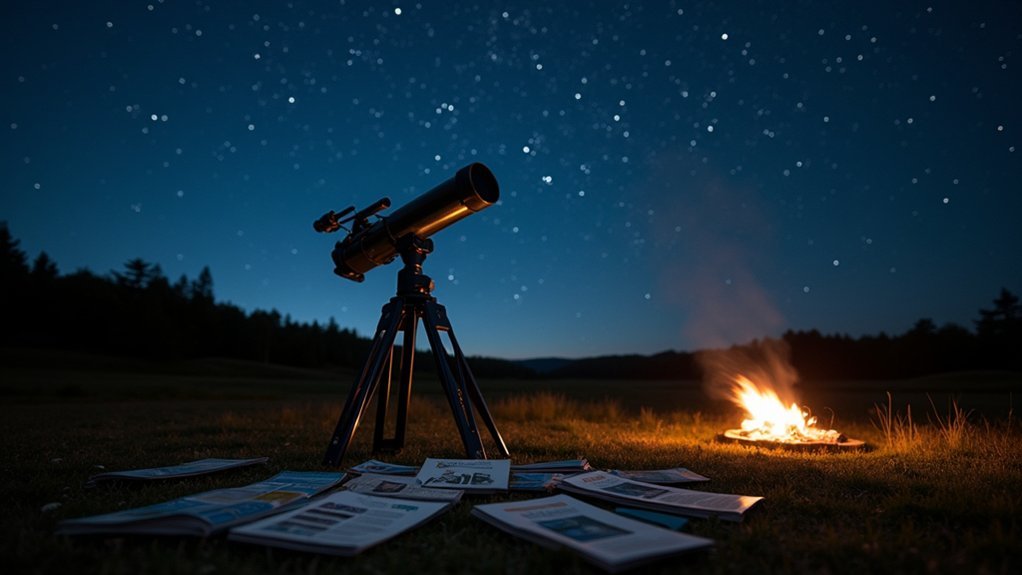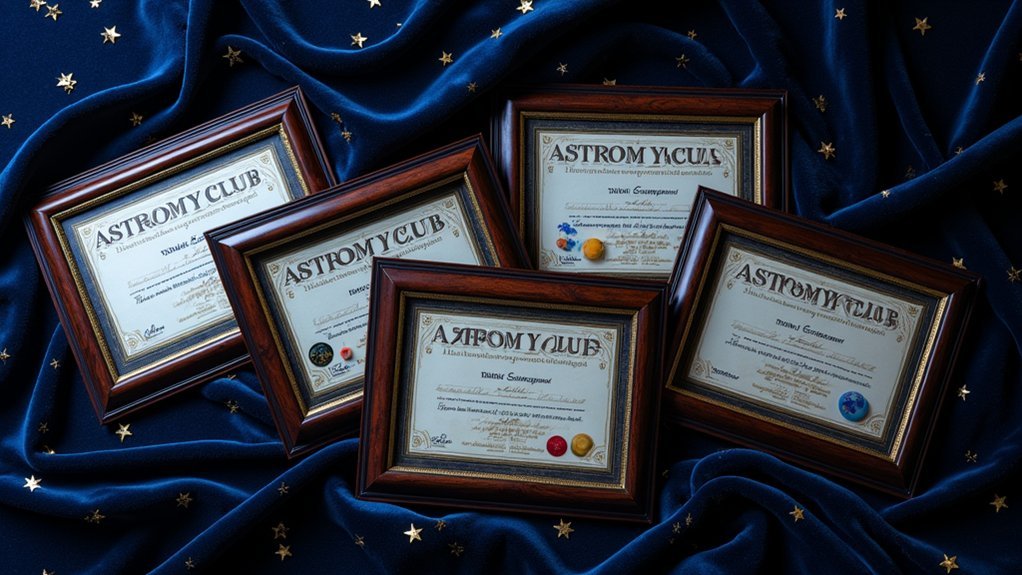When you're ready to explore the mysteries above, you'll need more than just a telescope and clear skies. A quality star wheel can transform your casual skyward glances into meaningful astronomical discoveries. Whether you're an amateur stargazer or sharing the wonders of the cosmos with your family, choosing the right planisphere makes all the difference. Let's explore seven stellar options that'll help you navigate the night sky with confidence and precision.
Look To The Sky Star Planisphere Wheel for Stargazing
The Look To The Sky Star Planisphere Wheel serves as an ideal starting point for budding astronomers and families enthusiastic to explore the night sky. You'll find this lightweight, weather-resistant tool easy to operate – simply dial in your date and time to locate celestial objects.
Built with dew-resistant laminated cardstock and a 24PT gloss inner dial, it's designed for outdoor use. While users praise its beginner-friendly features and portability, some mention concerns about its durability and a sticky wheel mechanism. Despite these drawbacks, at just 9 x 6 inches and 1 ounce, you can easily carry it during your stargazing adventures, whether you're using a telescope, binoculars, or just your eyes.
Best For: Beginner stargazers, families with children aged 8+, and casual astronomy enthusiasts looking for an affordable and simple tool to start exploring the night sky.
Pros:
- Easy to use with simple dial mechanism for finding celestial objects
- Weatherproof and dew-resistant design suitable for outdoor use
- Lightweight and portable at just 1 ounce with compact dimensions
Cons:
- Durability concerns with reports of flimsy construction
- Wheel mechanism tends to stick during rotation
- Limited customer reviews available to verify long-term reliability
The Night Sky 30°-40° (Large; North Latitude)
Designed for stargazers between 30° and 40° North Latitude, this durable plastic planisphere serves as an essential navigation tool for exploring the night sky. The 9×10.5-inch map features a 7-inch diameter viewing window and clearly marks the Milky Way's path.
You'll find this planisphere easy to use with its turn dial for date and time alignment. The clear protective cover and pliable storage case guarantee longevity. While it shows fewer deep-sky objects than some atlases, you can pair it with a red flashlight and additional guides for enhanced viewing. The South view appears on the back, and you might need a magnifying lens for detailed observation.
Best For: Amateur astronomers and stargazers located between 30° and 40° North Latitude who want an easy-to-use, durable tool for identifying celestial objects.
Pros:
- Durable plastic construction with protective cover and storage case ensures long-term use
- Simple turn dial system makes it easy to align date and time for accurate star viewing
- Clear markings and readable in dim light, with distinct representation of the Milky Way
Cons:
- Contains fewer deep-sky objects compared to comprehensive astronomical atlases
- South view requires flipping the planisphere over to access
- May require additional magnification for detailed viewing, especially for those with imperfect vision
Sky Gazing: Guide to Celestial Objects and Constellations
Young astronomers between ages 8 and 10 will find "Sky Gazing" an ideal companion for exploring celestial wonders. This hardcover guide features a glow-in-the-dark cover and stunning visuals that'll capture your imagination.
You'll love the book's digestible format, with Star Dude guiding you through complex astronomical concepts in simple terms. The colorful illustrations, photographs, and engaging activities make learning about the moon, sun, planets, and constellations both fun and memorable.
Whether you're homeschooling or learning in a classroom, you'll benefit from hands-on projects like building a red flashlight or pinhole projector for eclipse viewing. It's a practical, accessible resource that brings the mysteries of space down to Earth.
Best For: Young astronomers ages 8-10 and their families who want an engaging, visually appealing introduction to astronomy with practical hands-on activities.
Pros:
- Beautiful visual presentation with colorful illustrations, photos, and glow-in-the-dark cover
- Complex astronomical concepts broken down into kid-friendly, digestible chunks with Star Dude character
- Includes practical hands-on activities and projects for interactive learning
Cons:
- Age range might be too narrow for some families with children of different ages
- Hardcover format may be less durable for frequent handling by young children
- May be too basic for more advanced young astronomers who need deeper technical content
The Night Sky 40°-50° (Large) Star Finder
Stargazers living between 40 and 50 degrees north latitude will find this Chandler Planisphere indispensable for exploring the night sky. The blue-on-white print design works well with a dim red light, helping preserve your night vision while you locate celestial objects.
You'll appreciate the durable construction and pierced top for attaching a lanyard. While the instructions could be more detailed for beginners, you can pair this star finder with Peterson's Field Guide to Stars and Planets for enhanced learning. Combine it with Stellarium software to overcome light pollution challenges. For best results, join local astronomy clubs and consider using 8×56 binoculars before investing in a telescope.
Best For: Amateur astronomers and stargazing enthusiasts located between 40-50 degrees north latitude who want an accurate, easy-to-use tool for identifying celestial objects.
Pros:
- Durable construction with blue-on-white print that's readable with red light
- Works well for preserving night vision during stargazing sessions
- Includes convenient features like a pierced top for lanyard attachment
Cons:
- Instructions could be more detailed for beginners
- Paper dial may show wear over time with frequent use
- Size might be slightly small for comfortable reading in low-light conditions
Planet Learning Wheels – 12 Pieces
These planet learning wheels offer a hands-on way to explore our solar system, making them perfect for elementary school students and budding astronomers. You'll find colorful visuals and essential facts about each planet and the sun on these 10-inch cardstock wheels, which rotate smoothly on a metal brad.
The set includes 12 pieces, allowing you to focus on specific celestial bodies while learning their unique characteristics. Released by Oriental Trading Company in April 2023, these educational tools are lightweight at just 8 ounces and durable enough for regular classroom use. Whether you're teaching astronomy or simply want to spark interest in space exploration, these wheels provide an engaging learning experience.
Best For: Elementary school teachers, homeschool parents, and children aged 6-12 who are interested in learning about the solar system through interactive visual aids.
Pros:
- Engaging hands-on learning tool with rotating mechanism that keeps children interested
- Comprehensive coverage of all planets and the sun with key facts and visuals
- Lightweight and portable design makes it easy to use in different learning environments
Cons:
- Cardstock material may not be as durable as plastic alternatives
- Limited to basic planetary facts and may need supplemental materials for deeper learning
- Relatively low sales ranking suggests possible quality or engagement issues
Guide to the Stars
Astronomy enthusiasts seeking a reliable, non-digital star chart will find the Guide to the Stars invaluable for their stargazing adventures. This 16.25-inch diameter wheel covers northern latitudes from 30° to 60° and features clearly marked constellations, stars, clusters, and nebulas.
You'll appreciate the durable plastic laminate front that withstands moisture and outdoor use. The backside offers helpful information about telescopes, meteor showers, and celestial mythology. While you might need some practice aligning the chart with the night sky, you'll soon master locating objects like Andromeda and Uranus. Unlike digital apps, you won't worry about battery life or screen glare during your stargazing sessions.
Best For: Amateur astronomers and stargazing enthusiasts who prefer traditional navigation tools over digital apps and need a reliable star chart for latitudes between 30° and 60° North.
Pros:
- Durable plastic laminate front makes it weather-resistant and suitable for outdoor use
- Comprehensive reference material including constellations, stars, clusters, and helpful astronomy information on the back
- Functions without batteries or power, eliminating concerns about device failure during stargazing sessions
Cons:
- Requires practice and initial learning curve to properly align with actual sky views
- Back side lacks laminate protection making it potentially vulnerable to moisture damage
- Limited to Northern Hemisphere coverage between 30° to 60° latitude only
The Night Sky 20°-30°N (Large) Star Finder
Designed for observers between 20° and 30° north latitude, the Night Sky planisphere serves as an essential tool for residents in places like Hawaii, Florida, and Texas. You'll find this durable plastic star finder easy to read under red light, helping preserve your night vision during stargazing sessions.
While it won't replace your star atlas or observing guidebooks, this planisphere offers unique advantages over smartphone apps. You don't need to worry about battery life or screen glare. The high-contrast design shows both northern and southern views, complete with declination and right ascension numbers for precise celestial navigation. It's perfect for reconnecting with traditional astronomical practices in dark-sky locations.
Best For: Amateur astronomers and stargazers located between 20°-30° north latitude, particularly in regions like Hawaii, Florida, and Texas, who want a reliable, non-electronic way to navigate the night sky.
Pros:
- Durable plastic construction with high-contrast design that's easily readable under red light
- No batteries or charging required, unlike smartphone apps
- Includes helpful navigation features like declination and right ascension numbers
Cons:
- Limited to specific latitude range (20°-30°N), not suitable for other geographical locations
- Cannot replace comprehensive star atlases or observing guidebooks
- Static display doesn't show real-time planetary positions or changing celestial events
Factors to Consider When Choosing Star Wheels for Learning Constellations
When selecting a star wheel to learn constellations, you'll need to match your exact latitude for accurate star positions and choose a model that's sturdy enough to withstand nighttime viewing conditions. You'll want a star wheel that's large enough to read easily in dim light but still portable, with clear markings and weather-resistant materials that won't deteriorate from dew or occasional moisture. Consider starting with a simpler design if you're new to astronomy, then progress to more detailed models as your knowledge grows.
Latitude and Location Accuracy
Since star wheels serve as windows to the night sky, choosing one that matches your specific latitude is vital for accurate stargazing. Your location plays a significant role in how well your planisphere will function, as these tools are designed for specific geographical ranges.
If you're in southern states like Florida or Texas, you'll want to select a star wheel calibrated for 20°-30°N latitudes. For those living in regions between 30°-40°N, you'll need a different planisphere designed for your area. Using a star wheel that doesn't align with your latitude will result in distorted views of the night sky, making it challenging to identify constellations and stars correctly. Before making your purchase, always check the product's specified latitude range to guarantee it'll provide accurate celestial navigation for your location.
Durability for Outdoor Use
Because stargazing often requires extended outdoor sessions, your star wheel's durability will directly impact its long-term usefulness. You'll want to choose materials that can withstand moisture and environmental challenges, such as laminated gloss or high-reflective plastic.
Look for star wheels with weatherproof designs that won't deteriorate when exposed to dew or light rain. A sturdy construction prevents bending and damage, ensuring your tool remains functional throughout multiple stargazing adventures. While durability is vital, you don't have to sacrifice portability – many well-made options are both lightweight and robust.
Consider features like dew-resistant lamination and soft-touch cardstock that enhance performance in varying weather conditions. These protective elements will help your star wheel maintain its quality and readability, making it a reliable companion for your outdoor astronomical observations.
Size and Readability Features
The size of your star wheel plays an essential role in its effectiveness as a learning tool. While standard wheels measuring 9 to 10.5 inches offer excellent portability for beginners, you'll find larger 16.25-inch models provide enhanced detail for more serious stargazing.
You'll want to focus on readability features that make your star wheel practical in low-light conditions. Look for high-contrast printing and clearly labeled constellation names that won't strain your eyes. The best star wheels incorporate user-friendly turn dials, helping you quickly adjust dates and times to match the current night sky. When examining options, check for high-reflective plastic or laminated cardstock construction – these materials guarantee you'll be able to read your star wheel clearly, even during extended outdoor viewing sessions.
Material and Weather Resistance
Building on the importance of readability, your star wheel's material composition determines its performance and longevity in the field. You'll want to select options made from durable materials like laminated cardstock or plastic, which can withstand frequent outdoor use and handling.
Look for star wheels featuring weather-resistant properties, particularly those with dew-resistant laminates that won't deteriorate in varying environmental conditions. A 24PT laminated gloss material offers superior protection against bending and damage during transport. While durability is essential, you don't want to sacrifice portability – choose a lightweight option that you can easily carry to different observation sites. The material should also support clear print designs that remain visible in low-light conditions, ensuring you can identify celestial objects effectively during your nighttime observations.
Educational Value and Complexity
When choosing a star wheel for constellation learning, your primary consideration should be how effectively it balances educational content with user-friendly design. Look for clear labeling and straightforward instructions that won't overwhelm you as a beginner but will still provide room for growth as your knowledge expands.
You'll want a star wheel that includes deep-sky objects, star clusters, and galaxies to enhance your understanding of the night sky. The ability to adjust settings for specific dates and times lets you practice real-time observation, making your learning more practical and engaging. Consider complementing your star wheel with hands-on activities and supplemental guides to maximize your educational experience. This combination of features will help you build a solid foundation in astronomy while keeping you motivated to explore further.
Frequently Asked Questions
Can Star Wheels Be Used in the Southern Hemisphere?
You'll need a star wheel specifically designed for the Southern Hemisphere, as standard Northern Hemisphere ones won't work correctly. Many manufacturers offer Southern Hemisphere versions that'll show you accurate star positions down under.
How Long Does a Typical Star Wheel Last Before Needing Replacement?
If you take good care of your star wheel, it'll last many years. They're made of durable plastic or cardstock that won't easily wear out. You'll only need replacement if it's damaged or lost.
Are Star Wheels Accurate Enough for Astrophotography Planning?
While you'll find star wheels helpful for basic planning, they're not precise enough for serious astrophotography. For accurate camera alignment and timing, you'll want to use digital planetarium software or specialized astronomy apps instead.
Do Star Wheels Work During Daylight Hours for Educational Purposes?
You can use star wheels during daylight hours to teach celestial concepts, but you won't see the actual stars. They're great for demonstrating star positions, constellations, and celestial movement in educational settings.
Can Children Under Eight Years Old Effectively Use Star Wheels?
You'll find star wheels are challenging for children under eight to use independently. They often need adult guidance to align and read the disk correctly, but they can still learn from observing with supervision.
In Summary
You'll find these seven star wheels offer different ways to explore and understand the night sky, whether you're a beginner or experienced stargazer. Remember to contemplate your latitude, durability needs, and intended use when selecting your ideal wheel. With the right star wheel in hand, you're ready to commence celestial adventures and reveal the mysteries of constellations right from your backyard.





Leave a Reply